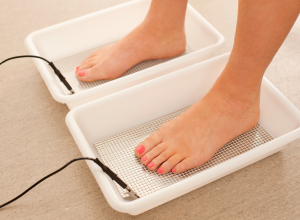
Iontophoresis
Iontophoresis is a technique that introduces ionic medical compounds into the body via electrical currents. It is a common procedure to combat plantar hyperhidrosis, which is abnormal excessive sweating of the feet.
Iontophoresis has been around since the 1940s and has been used to treat a number of ailments, including bursitis, plantar fasciitis, tennis/golfer’s elbow (lateral and medial epicondylitis, respectively), and some types of plantar hyperhidrosis. It is especially useful for patients who have tried traditional treatments without success.
Iontophoretic therapy is a type of electromotive drug administration (EMDA) that essentially is an injection without a needle. Electrical currents pass through water and administer ionizable medication (or other chemical) transdermally, with the medication most often administered being anti-inflammatory drugs. As it stands, there are no serious side effects of iontophoretic therapy and those who partake in the therapy on a weekly basis usually experience long-term benefits.
There are two prescription, plug-in iontophoresis devices registered and cleared with the U.S. Food and Drug Administration (FDA): R.A. Fischer devices and Hidrex devices. A typical iontophoresis session usually lasts about 30 minutes.
In the case of plantar hyperhidrosis, studies have found that iontophoresis helps about 80 to 90 percent of patients who try the method.
Notice concerning medical entries:
Articles having medical content shall serve exclusively for the purpose of general information. Such articles are not suitable for any (self-) diagnosis and treatment of individual illnesses and medical indications. In particular, they cannot substitute for the examination, advice, or treatment by a licensed physician or pharmacist. No replies to any individual questions shall be effected through the articles.






